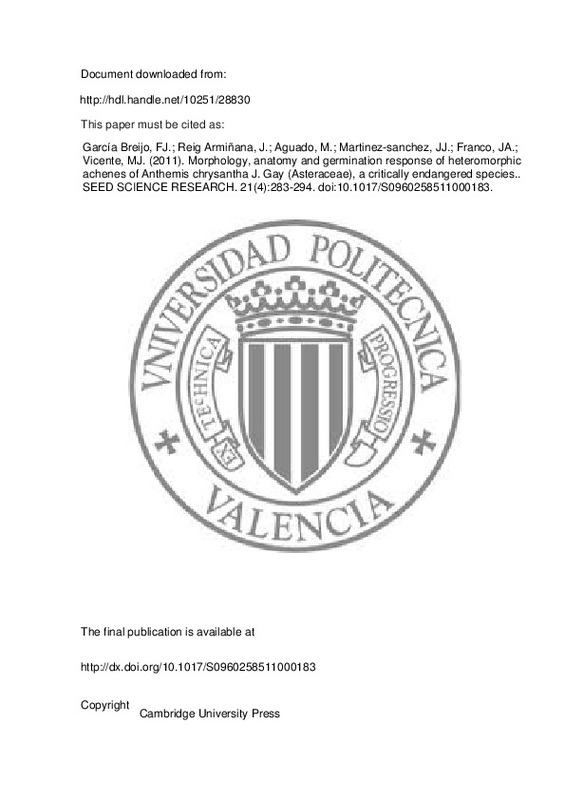JavaScript is disabled for your browser. Some features of this site may not work without it.
Buscar en RiuNet
Listar
Mi cuenta
Estadísticas
Ayuda RiuNet
Admin. UPV
Morphology, anatomy and germination response of heteromorphic achenes of Anthemis chrysantha J. Gay (Asteraceae), a critically endangered species
Mostrar el registro sencillo del ítem
Ficheros en el ítem
| dc.contributor.author | Aguado, Mayra
|
es_ES |
| dc.contributor.author | Martinez-Sanchez, Juan J.
|
es_ES |
| dc.contributor.author | Reig Armiñana, José
|
es_ES |
| dc.contributor.author | García Breijo, Francisco José
|
es_ES |
| dc.contributor.author | Franco, Jose A.
|
es_ES |
| dc.contributor.author | Vicente, Maria J.
|
es_ES |
| dc.date.accessioned | 2013-05-14T12:01:13Z | |
| dc.date.available | 2013-05-14T12:01:13Z | |
| dc.date.issued | 2011 | |
| dc.identifier.issn | 0960-2585 | |
| dc.identifier.uri | http://hdl.handle.net/10251/28830 | |
| dc.description.abstract | [EN] This study demonstrates that Anthemis chrysantha, a 'Critically Endangered' annual plant, produces two morphs of achenes: white and dark achenes, which differ in size, mass, anatomy and germination behaviour. Fresh white achenes germinated at all temperatures assayed from 10 to 25 degrees C in both continuous darkness and 12-h photoperiod, ranging between 24% at 25 degrees C in darkness and 89% at 12/20 degrees C in light, whereas fresh dark achenes did not germinate under any temperature or light conditions. To identify differences in dormancy type between the two morphs, germination of dry-stored achenes, and achenes stratified at 5 or 25 degrees C for 2 months were tested in both darkness and light at 5, 15 and 12/20 degrees C for dry-stored and warm-stratified (25 degrees C) achenes; and at 15, 25 and 12/20 degrees C for cold-stratified (5 degrees C) achenes. Of the white achenes, 90% germinated during the cold stratification period. In general, dry storage and warm stratification did not increase germination compared to fresh achenes. However, dark achenes did not germinate under any conditions. Dark achene dormancy was only broken by mechanical scarification or by excising the embryo (germination reached 71%). An anatomical study showed that the mesocarp of dark achenes had no intercellular spaces and was much thicker and stronger than that of white achenes, making the entry of water difficult, and also preventing germination by mechanical restriction. This study demonstrated that dormancy in the dark achenes is likely caused by the thickness of their pericarp, physically impeding germination and hampering imbibition of water. | es_ES |
| dc.description.sponsorship | This work was financed by the Consejeria de Agricultura y Agua de la Comunidad Autonoma de la Region de Murcia and the Fundacion Seneca de la Region de Murcia (Project 1186/PI/09). | en_EN |
| dc.language | Inglés | es_ES |
| dc.publisher | Cambridge University Press | es_ES |
| dc.relation.ispartof | Seed Science Research | es_ES |
| dc.rights | Reserva de todos los derechos | es_ES |
| dc.subject | Anthemis | es_ES |
| dc.subject | Endangered species | es_ES |
| dc.subject | Heteromorphic fruits | es_ES |
| dc.subject | Pericarp structure | es_ES |
| dc.subject | Seed dormancy | es_ES |
| dc.subject | Seed germination | es_ES |
| dc.subject.classification | BIOLOGIA VEGETAL | es_ES |
| dc.subject.classification | BOTANICA | es_ES |
| dc.title | Morphology, anatomy and germination response of heteromorphic achenes of Anthemis chrysantha J. Gay (Asteraceae), a critically endangered species | es_ES |
| dc.type | Artículo | es_ES |
| dc.identifier.doi | 10.1017/S0960258511000183 | |
| dc.relation.projectID | info:eu-repo/grantAgreement/f SéNeCa//1186%2FPI%2F09/ | es_ES |
| dc.rights.accessRights | Abierto | es_ES |
| dc.contributor.affiliation | Universitat Politècnica de València. Departamento de Ecosistemas Agroforestales - Departament d'Ecosistemes Agroforestals | es_ES |
| dc.description.bibliographicCitation | Aguado, M.; Martinez-Sanchez, JJ.; Reig Armiñana, J.; García Breijo, FJ.; Franco, JA.; Vicente, MJ. (2011). Morphology, anatomy and germination response of heteromorphic achenes of Anthemis chrysantha J. Gay (Asteraceae), a critically endangered species. Seed Science Research. 21(4):283-294. https://doi.org/10.1017/S0960258511000183 | es_ES |
| dc.description.accrualMethod | S | es_ES |
| dc.relation.publisherversion | http://dx.doi.org/10.1017/S0960258511000183 | es_ES |
| dc.description.upvformatpinicio | 283 | es_ES |
| dc.description.upvformatpfin | 294 | es_ES |
| dc.type.version | info:eu-repo/semantics/publishedVersion | es_ES |
| dc.description.volume | 21 | es_ES |
| dc.description.issue | 4 | es_ES |
| dc.relation.senia | 39039 | |
| dc.contributor.funder | Fundación Séneca-Agencia de Ciencia y Tecnología de la Región de Murcia | es_ES |
| dc.contributor.funder | Comunidad Autónoma de la Región de Murcia | es_ES |







![[Cerrado]](/themes/UPV/images/candado.png)

